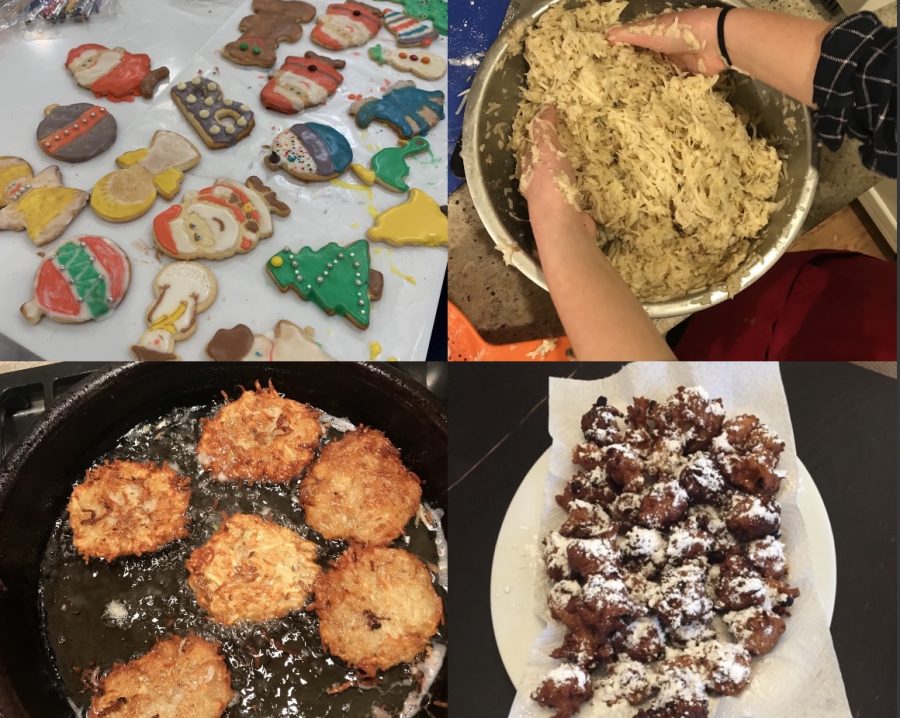‘Tis the season to cook: students whip up tasty holiday food traditions
Photos courtesy Julie Bravo, Dani Klein, Fenna Oliphant-Linden
Top left: Bravo’s cookies, top right and bottom left: Klein’s latkes, bottom right: Oliphant-Linden’s oliebollen
December 30, 2021
To many, the holiday season means festive lights, familiar holiday tunes and eager awaiting of the first snowfall. Perhaps most importantly, however, the festive time of year brings about the revival of delicious holiday foods. From connecting students to their heritage to simply spreading joy, these dishes have one thing in common: they are made with endless holiday spirit and love.
Family recipes that have traveled through generations can, for some students, make culinary traditions especially sentimental. Junior Julie Bravo and her grandmother have baked up a storm with Bravo’s great-great-grandmother’s delectable sugar cookie recipe — which uses almond extract as the special ingredient — every holiday season since she can remember.
“It’s been a tradition since my mom was a kid, too,” Bravo said. “My great-great-grandma made the recipe that we use, so this tradition has been in our family for a long time.”
Bravo, who often sneaks bits of cookie dough when her grandmother isn’t looking, enjoys bringing her family’s sacred Christmas cookies to life. To prepare the dessert, she and her grandmother make the dough, roll it out and use cookie cutters to mold the dough into holiday-themed shapes like Christmas trees, bells and rocking horses.
“Over the years, we’ve accumulated three big bags full of different cookie cutters, and they’re all Christmas themed,” Bravo said.
However, the holiday tradition is hardly over once someone in the Bravo household has lifted the tray of cookies out of the oven. Making the cookies isn’t Bravo’s favorite part — it’s decorating the treats that’s the most exciting, she said. The Bravos sit around their kitchen table, which is lined with bowls full of different colored icings; approaching the process with both precision and delight, Bravo and her family ice their cookies.
“We use all these different colors and frost according to what the certain symbols look like in real life and also switch it up to make cool designs like tie-dye,” Bravo said. “It’s fun to be creative and play Christmas music in the background to get into the holiday spirit.”
Bravo especially cherishes her cookie-making tradition because she loves spending time with her grandmother and extended family, whom she only gets to see a few times every year. Gaining easy access to a supply of freshly baked cookies doesn’t hurt either, she said.
Junior Justin Yang’s family also prepares a special Christmas delicacy every year, although this dish trades in sweetness for spiciness.
The traditional Chinese cuisine that graces Yang’s family’s Christmas dinners doesn’t resemble the roast chicken or mashed potatoes that one might find at a classic American feast on December 25. Instead, Christmas dinners at the Yangs consist of stir fry vegetables, roast chicken, steak and — their hallmark — Dan Dan noodles.
These cherished chili oil noodles originate from the Sichuan province of China, where Yang’s father’s family is from. Dan Dan noodles, or Dandan mian, is the region’s most famous dish. For Yang, Dan Dan noodles embody the holiday spirit, incorporate East Asian flavors that honor his culture and satisfy his taste buds, he said.
A plate of Dan Dan noodles on the Yang table consists of hand-pulled noodles mixed with a chili oil sauce made of avocado oil, chili peppers and traditional Chinese five-spice powder. Freshly cut garlic tops off the dish. Yang said the Dan Dan noodles always have the perfect level of spiciness.
Yang has spent Christmas with his grandparents for as long as he can remember, and year after year, his grandmother’s dedication to chopping the garlic stands out to him, he said.
“The dish itself is fairly simple, but the tedious process my grandma shoulders of peeling the garlic cloves and mincing them to put on top of the noodles is what I appreciate most,” Yang said.
While Yang’s grandmother used to be the head Christmas chef, Yang recently took on the role. When he was 14, Yang began cooking the Dan Dan noodles with help from his parents.
“Even though my grandma doesn’t cook the full dish anymore, she still insists on chopping the garlic,” Yang said. “She really does care, and it means a lot that she still wants to contribute to the dish.”
Like Yang, senior Fenna Oliphant-Linden has a holiday food tradition that isn’t of American heritage. Oliphant-Linden’s favorite holiday dish — oliebollen, or Dutch fried donuts — comes from the Netherlands. Oliphant-Linden has prepared these sweet delicacies every year on New Year’s Eve with his father since he was five.
“It’s special to me because it’s one thing that never changes; no matter where we are, we always have to make it,” Oliphant-Linden said. “My dad will always take out my grandma’s old apron and put it on to make them, and we use her recipe. It’s meaningful to know that this tradition will carry on to my kids and grandkids and everything.”
The oliebollen creation process entails forming a thick dough and then adding sweet ingredients like apples and raisins into the mix. Oliphant-Linden rolls the dough into small spheres that boil in oil on the stove once formed. The fried oliebollen pile on one another into a small tower on a massive white platter, and after a dusting of powdered sugar, the family’s New Year’s Eve treats are complete.
“It’s always an exciting feeling to finally be done with them and eat them because by the time we’re done with them it’s usually one or two p.m., and by that point, it’s starting to really hit me that it’s the end of the year,” Oliphant-Linden said. “Once I have an oliebol, it feels like New Year’s Eve and like it’s a holiday.”
Oliphant-Linden and his family typically sit around the kitchen table and enjoy their first oliebol of the year together. Later, they pack extras into boxes for neighbors and friends. This tradition brings Oliphant-Linden closer to his family members from his dad’s side, all of whom reside in the Netherlands, he said.
“Every year we all send pictures to our family group chat of our different oliebollen and it connects us in a way,” Oliphant-Linden said. “It’s a really nice feeling and the reason why we carry on the tradition each year, to stay tied to family.”
Similarly, sophomore Dani Klein views her unique Hanukkah tradition as an avenue to connect with her family, as well as a way to commemorate the Jewish holiday.
While most latkes — fried potato pancakes — highlight the taste of grated potato, the Klein family prefers to stray from the traditional recipe. The Kleins work together each year to incorporate unique flavors into their latkes, often taking advantage of fresh produce from their backyard garden.
In previous years, the Klein family has featured ingredients like sweet potato, baby red potato, chives, leeks, pepper, turkey bacon, raisins, citrus, cheese and egg in their latkes.
“We just try a lot of crazy stuff and see what works out well,” Klein said. “It’s really fun because we get to use things from our garden, and we also get to cook together.”
Klein, her older sister, her mom and her dad had prepared these one-of-a-kind latkes for Hanukkah for seven years, ever since Klein’s sister became interested in cooking when she was 12. When it comes to making the foundational potato pancake, they use a recipe from Klein’s aunt — but when it’s time to add special ingredients, the Kleins let their creativity take the lead. Klein appreciates that this holiday tradition is distinctive to her family, she said.
“It’s special any time we get to use the food that we grew, but testing new recipes is more fun than if we were all to make normal latkes together because everyone does that,” Klein said. “We added our own spin by experimenting — you never know what’s going to happen and that makes it fun for the family.”
Above all, making this latke dish with family — like the Christmas cookies, Dan Dan noodles and oliebollen — evokes a sense of home and allows for a sweet escape from the outside world.
“It’s a really fun way to observe the holiday because everything’s really crazy around this time of year, but we always get to light the candles and then have traditional Jewish food,” Klein said. “It reminds us that we are in a holiday, and it’s a break from the chaos happening in our normal lives.”









